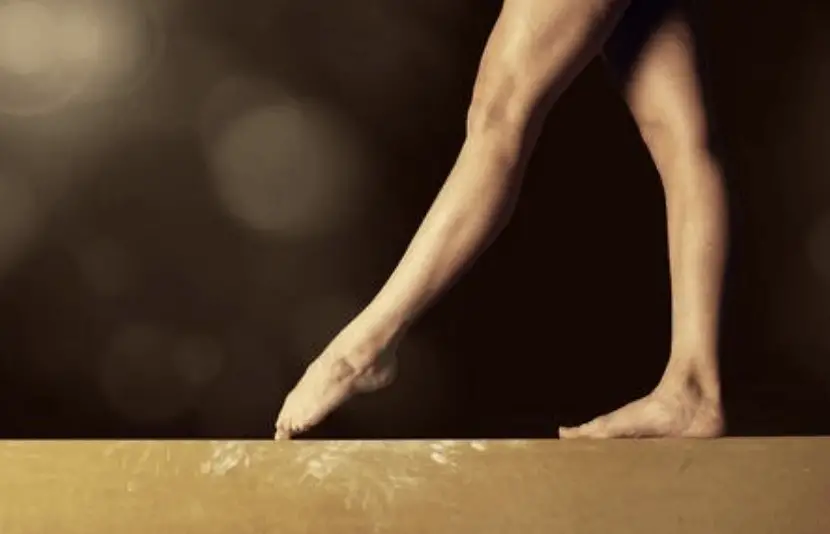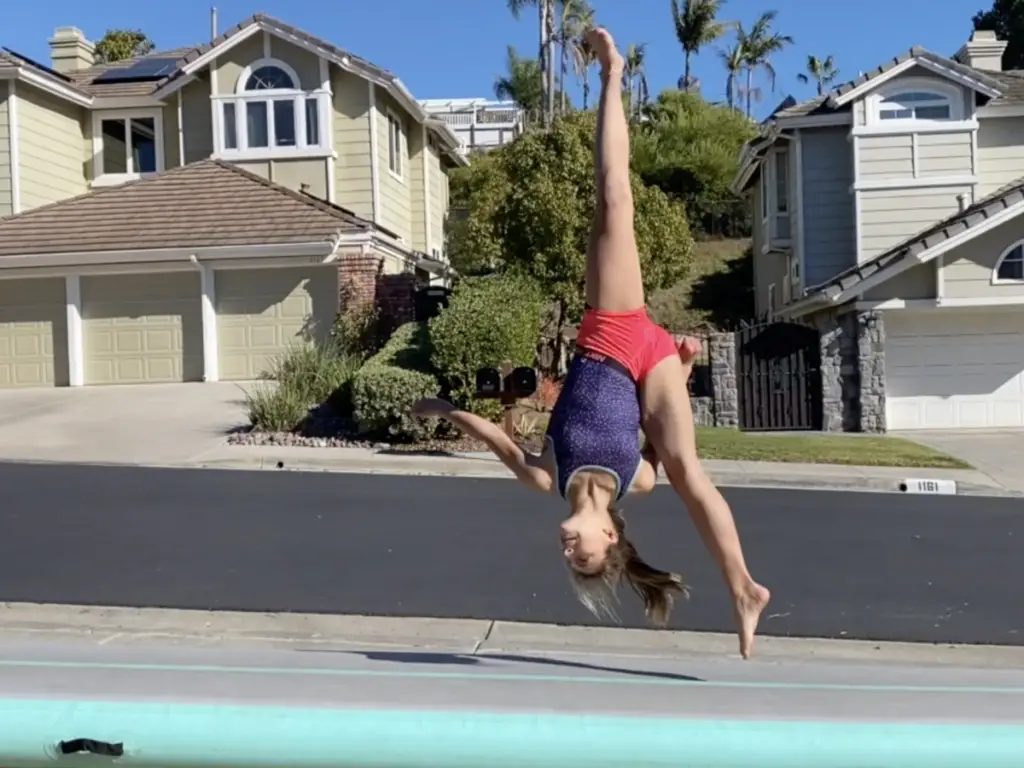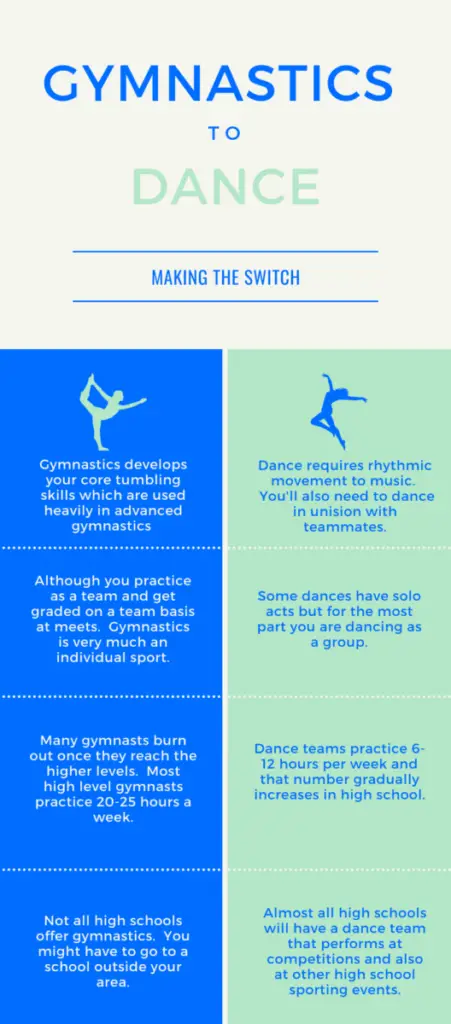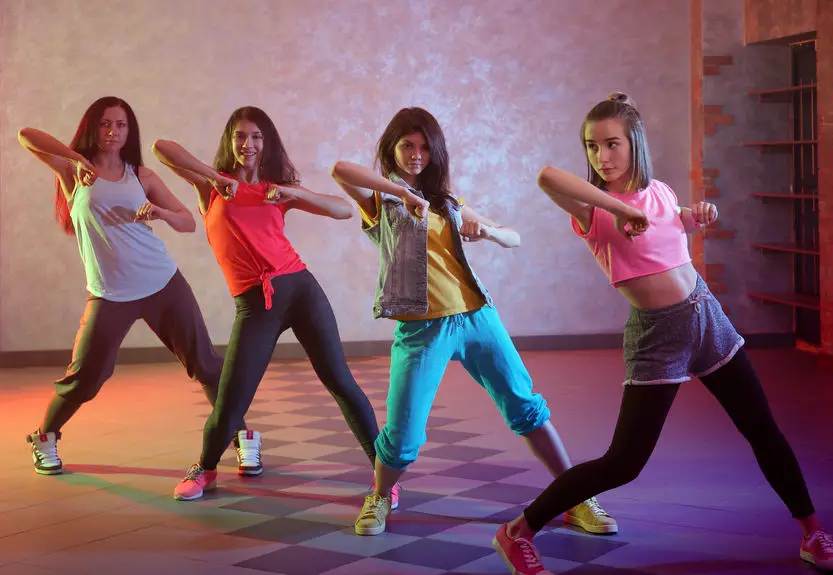Many gymnasts will reach a crossroads as they approach high school. They must choose to continue their pursuit of reaching level 10 gymnastics or take a different route and switch sports. Dance is one of the more popular sports that gymnasts will transition too. In this post we’ll dive deep into the all aspects of this transition.
Switching from gymnastics to dance can be an easy transition for young athletes. The advanced acrobatic tumbling skills will give you an edge in many dance routines. Gymnasts should be prepared to practice thei rhythmic movements withing a group as that is a focal point for dance teams and is not a skill developed in traditional gymnastics.
You will face challenges as you make the move to dance and there are positive and negative things you might experience. Let’s dive into the tough events you’ll face during this transition. We will also explore the positive and negative parts once you complete the transition to your new sport.
Differences Between The Two Sports
Gymnastics is an individual sport with some team elements. Dance requires choreographed routines that are performed as a group in a synchronized manner. Gymnastics requires high level acrobatics with specialized skills on various apparatus. Gymnastics does not require music except for the floor routine.
Solo Or As A Team
One of the hardest parts of transition to dance is the switch from relying on yourself to relying on your teammates. There are some team elements to gymnastics but you never actually perform together at the same time. Each gymnast is responsible for their own performance at each apparatus.

If you mess up it’s on you.
Compare this to dance which is a highly synchronized sport where each individuals performance is directly related to the team and impact the teams score. Many gymnastics can find this switch difficult. Part of the growth during this transition is to learn to work as a team and learning how to be a good teammate.
Picking up a teammate that falls out of step in a big performance would be an example of being a good teammate.
Staying Synchronized
Dance teams require a high level of synchronization in order to score high. Having 10, 15 or even 20 individuals all following along at the exact same beat takes lots of practice. This is a skill that many gymnasts will struggle with as they switch to dance.
A few tips to staying synchronized are:
- Counting It Out – Basically you’ll be counting out the beats of the music to coincide with the movements of the dance.
- Tighten Up The Movements – Paying special attention to hand movements, leg movements and head movements all make a big difference in staying synchronized. These slight adjustments will make a huge difference.
- Floor Placement – Getting technical with your floor placement will help in keeping each dancer separated and keep all the dancers moving in one fluid motion.
Flying High

Higher level dance teams will have some of the athletes perform advanced acrobatics like round offs, cartwheels, aerials, back hand springs and back flips. But for the most part the high flying events are saved for gymnastics.
If you are an advanced gymnast level 5 or higher you might be one of the few athletes chosen on the dance team to perform the more acrobatic parts of the routine.
Feeling the Beat
Other than the floor routine you won’t be dancing to any beats in gymnastics. The bars, beam and vault do not have any music associated with the event. The All dances are based on music and it plays a huge role in the performance.
If you love doing your floor routine you’ll probably love making the switch to gymnastics. Dance performances are filled with popular songs from past and present.

Similarities Between The Two Sports
Both gymnastics and dance require flexibility and a strong core. You will need to be able to perform dynamic movements in a public setting in front of an audience. Although both sports are artistic in nature you are required to show competency in certain skills to get a high score.
Flexibility & Core Strength
Having a strong core and flexibility are critical elements for both gymnastics and dance. Most teams will spend a good portion of the practice working on both of these skills. Without a base layer of strength in gymnastics you won’t be able to perform the more advanced skills.
Same goes for the flexibility in both sports. You must be flexible in order to contort you body into the movements that judges are looking for in competitions. Flexibility in your back, legs and torso are key to having success in both sports.
Feeling The Pressure
The pressure to perform in front of a crowd is similar in both sports. In gymnastics you’ll performing on your own so the pressure truly rests on your shoulders. You’re teammates will benefit from the team score at meets but it isn’t weighted as much as dance. In dance you’ll feel the pressure from the crowd and your teammates. You don’t want to make a mistake in a group dance and let your team down.
How To Score
Both sports require certain movements that you will be scored. Finishing poses without taking extra steps, extending your arms, hands and feet without making extra movements are both keys to getting high scores. The scores can seem arbitrary at times but the judges do have a set of elements they are looking for in each event or dance.
If you can perform those specific elements well you’ll end up scoring high. Scoring in dance is very similar to the scoring in gymnastics so most gymnasts won’t find that transition difficult.
Should I Start Out In Dance Or Gymnastics
Are you a younger athlete that is just starting out in sports? If so, you might be at a crossroads between starting out in dance or gymnastics. Some will find the acrobatics in gymnastics more fun. Others will enjoy dancing to music and go that route.
You really can’t go wrong with either path but the transition from gymnastics to dance will be easier down the road. Gymnastics builds an incredibly strong foundation in girls that reach level 6+. The hours of gymnastics training does pay off. The skill set you learn translated to many sports and especially to dance.
On the other had you can start in dance and transition to gymnastics but you might find it hard to advance to the higher gymnastics levels quickly. Each level requires difficult skills that require you overcoming your fears and having tremendous body strength.
In the end most athletes will find it easier to transition from gymnastics to dance as they get older.
What It’s Like To Join A High School Dance Team
When you first get involved in High School Dance, you are going to be a bit overwhelmed with the amount of skills you’ll need to develop. You will want to practice as much as possible and use your high school coaches, YouTube instructional videos and tips from experienced gymnasts, as they will help you build your self confidence in the sport. Once you make the high school dance team, you will need to immerse yourself in the team and workhard at every workout and team event.
Once you do join a team, make sure that you have a great support system, and try to get a lot of help from your teammates and coaches. They are going to want to know what is going on, and may want to be part of the team themselves. Gymnastics is a very individual sport where you are only relying on yourself. Dance is very much a team sport where you are relying on your teammates. If you are struggling with something new, you should, by all means, take classes, watch videos, and even get personal training to help you out.
Conclusion
Gymnastics and dance are two great options for young athletes. Both sports have grown in popularity and are readily available in most geographic locations. I hope yo found some value from this article if you are one of those gymnasts that are contemplating making the switch to dance.

